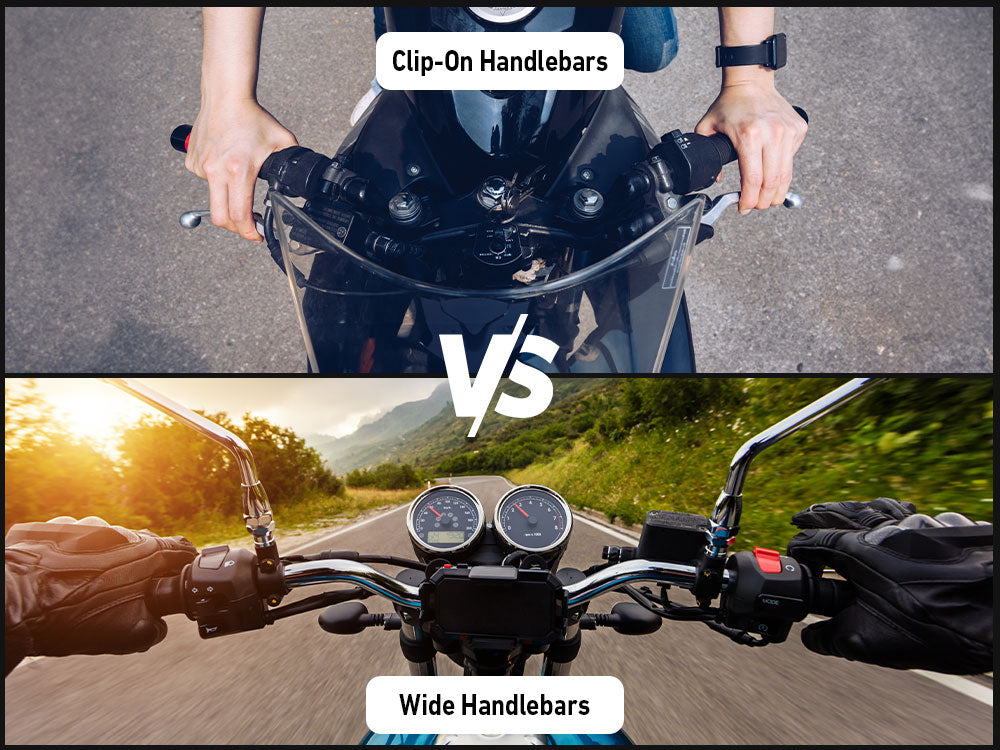Table of Content
1. Introduction
When you consider the most important component of your motorcycle, your mind will likely first think of the braking system or the engine. Of course, these motorcycle parts are essential to ensuring a safe and comfortable riding experience. However, your motorcycle’s systems cannot work to their full potential if there is no way to control, balance, or steer your vehicle. Motorcycle handlebars are the only means of steering your two-wheeler; without them, you cannot hope to reach your destination safely.
Different motorcycle handlebar types are built for every known model and vehicle type from all the popular brands, including Harley Davidson, Honda, Suzuki, Kawasaki, Yamaha, Victory, Indian, and Triumph. Each type of motorcycle handlebar is built from different materials, has varying dimensions, and has distinct overall looks. They can be universally accessible or only suited for shorter, taller, newer, or experienced riders. Two popular choices among riders are wide and clip-on handlebars.
Though they both fulfill the same purpose, wide and clip-on handlebars have their lists of advantages and disadvantages that make them favorable to use in certain situations and when installed on certain kinds of motorcycles.
2. Wide Handlebars

Wide handlebars refer to a genre of motorcycle handlebars, which includes ape-hanger and drag bars. This category is known for its single-piece handlebars with a much wider gap between the grips and the steel rods than most standard variants. Due to having such a spacious horizontal length, wide handlebars are better suited for average or taller riders. You will often find wide handlebars installed on cruisers, standard, or dirt bikes.
Due to the wide handlebars’ dimensions, this component provides more leverage, making it easier to change direction with only slight prompting and to handle your motorcycle when traveling at lower speeds. If you want to sit in a more comfortable riding position, you can adjust the placement of the wide handlebars forward or backward to make it easier to grab the handles.
Since wide handlebars cover a broad range of handlebar types, they come in multiple designs and styles that satisfy different aesthetic appeals. They can either come with several bends along the handles or can be an almost perfectly straight rod. Whether you prefer handlebars that prioritize function or style, you should have little difficulty finding a set of wide handlebars that suit your needs.
However, wide handlebars tend to be made of heavy steel materials that can prove time-consuming when trying to mount to your motorcycle’s front. If you ride a lightweight motorcycle, wide handlebars may cause an uneven weight distribution that could make it easier to dip forward.
Wide handlebars require you to spread your arms almost fully apart when grabbing the handles, increasing your body’s surface area being blown against by the wind. This results in increased wind resistance which can cause your motorcycle to slow down when cruising at high speeds.
Because wide handlebars have such large dimensions, it can take too long to turn them toward the far left or far right. Whether riding on a highway or traveling through the city, you cannot safely clear tight corners in either direction without the risk of losing your balance.
2.1 Pros of Wide Handlebars
- Adjustable
- Offers better leverage
- Can change direction with little prompting
- Suited for average and taller riders
- Installed on cruisers, dirt bikes, & standard motorcycles
- Better suited for low-speed travel
- Broad category of diverse handlebar types
- Diverse style, design, and feature choices
2.2 Cons of Wide Handlebars
- Heavier
- Take more time to install
- Can cause uneven weight distribution
- Less aerodynamic
- Difficulty quickly turning tight corners at low & high speeds
3. Clip-On Handlebars

Clip-on handlebars are two-piece equipment that can be installed on, above, or below the motorcycle’s front fork. The handles come separately, which makes it easier to mount, remove, and carry them. During installation, you must make sure the handles are equidistant from each other and properly aligned with the rest of the motorcycle. It is easier to adjust the position of the handlebars when putting them above or below the front fork. However, if it is mounted onto the front fork, the clip-on handlebars become non-adjustable.
Regardless of how the clip-on handlebars are positioned, they provide a forward riding position that requires riders to lean slightly forward. This riding position helps keep the rider’s body at a low height and streamlined, which improves the motorcycle’s aerodynamics and reduces air resistance.
Though clip-on handlebars are compatible with standard motorcycles, cruisers, and café racers, they are best suited to sports bikes. This is because clip-on handlebars can be quickly turned to the right or left without any loss of balance, making them ideal for riding on race tracks and clearing tight corners in urban areas.
To use clip-on handlebars effectively requires an experience level equal to intermediate and expert riders. Also, because the riding position requires you to remain slouched forward, which can strain your back, these handlebars are not ideal for long-distance trips and traveling at slow speeds. You also need to be mindful of how far you turn the handlebars since they have a tighter turn radius and could accidentally hit the fuel tank or front fairing.
3.1 Pros of Clip-On Handlebars
- Adjustable
- Easy to install
- Can change direction with little prompting
- Can quickly turn tight corners at low & high speeds
- Improves aerodynamics
- Suited for intermediate & expert riders
- Suited for cruisers, café racers, and sports bikes, & standard motorcycles
3.2 Cons of Clip-On Handlebars
- Non-adjustable if attached directly to the front fork
- Uncomfortable riding position
- Not suited for long-distance travel
- Difficult to control at low speeds
- Tighter turning radius
4. Similarities & Differences Between Wide & Clip-On Handlebars
| Similarities | Differences |
|---|---|
| Adjustable handlebar positions | Wide handlebars are a broad category, while clip-on handlebars are a specific type |
| Wide handlebars are suited for long-distance travel, while clip-on handlebars are not | |
| Can easily change direction when traveling straight | Wide handlebars are easy to handle at low speeds, while clip-on handlebars perform best at high speeds |
| Wide handlebars are heavier and take more time to install, while clip-on handlebars are lightweight and easier to install | |
| Can be installed on standard motorcycles & cruisers | Clip-on handlebars can clear tight corners at any speed, while wide handlebars cannot |
| Wide handlebars have more style, diversity, and designs than clip-on handlebars | |
| Suited for average/intermediate riders | Wide handlebars can be installed on dirt bikes, while clip-on handlebars can be installed on cafė racers & sports bikes’ |
| Clip-on handlebars offer better aerodynamics than wide handlebars |
5. Which is Better?
Wide handlebars are the better option if you prefer having access to more diverse styles, designs, and features. This category covers several handlebar types, including drag and ape-hanger bars, which are suited for different road conditions and distances. If you rely on your motorcycle for short daily commutes or long highway excursions, then wide handlebars offer this balance and versatility. Due to being heavily built, they will withstand more damage and last longer than standard motorcycle handlebars. If you are the owner of a standard motorcycle, cruiser, or dirt bike, it is possible to install a set of wide handlebars. Though it varies between the types of handlebars that are considered wide handlebars, they are usually best suited for average or taller riders.
Clip-on handlebars are the better option if you frequent race tracks or travel often on highways. This handlebar type requires riders to lean slightly forward, making their body more streamlined and reducing air drag. Clip-on handlebars ensure better aerodynamics and maneuverability when traveling at high speeds. This allows riders to turn tight corners without slipping or losing balance. Due to being lightweight, these handlebars are easy to carry and store when unused and take little time to mount to your motorcycle’s front end. Clip-on handlebars are better suited for intermediate and expert riders who know how to react quickly and safely navigate.













Leave a comment
All comments are moderated before being published.
This site is protected by hCaptcha and the hCaptcha Privacy Policy and Terms of Service apply.